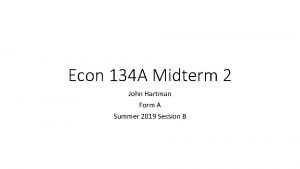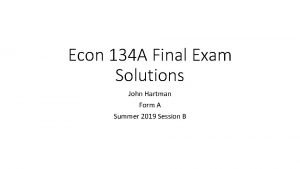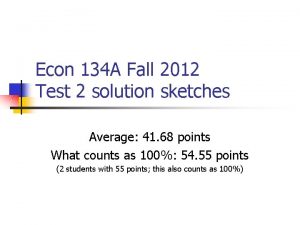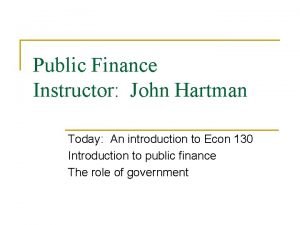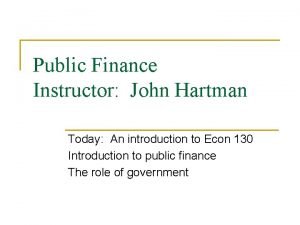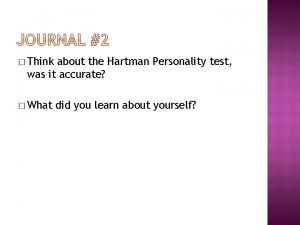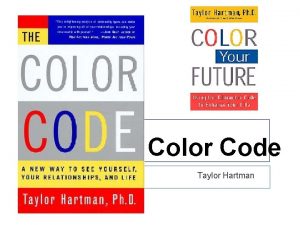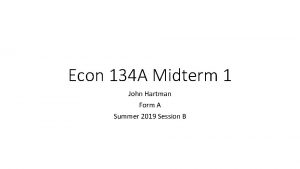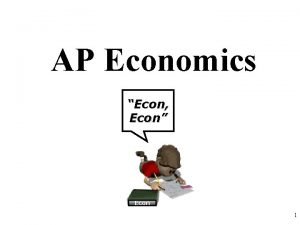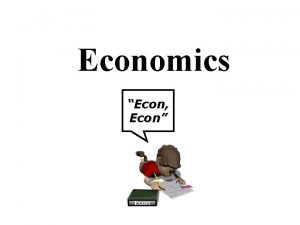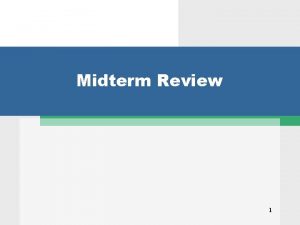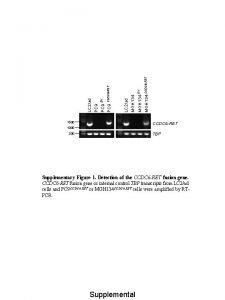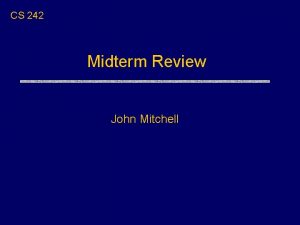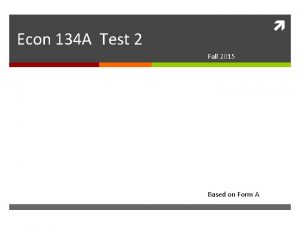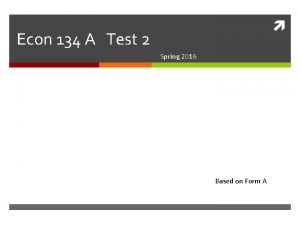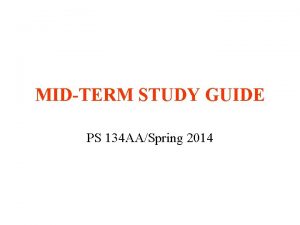Econ 134 A Midterm 2 John Hartman Form

















- Slides: 17

Econ 134 A Midterm 2 John Hartman Form A Summer 2019 Session B

Q 1 • Suppose that you know the following information about a bond: It has a face value of $500, the effective annual interest rate for this bond is 9%; there will be 10 equal annual coupon payments, starting one year from today; the bond matures 10 years from today; the present value of the bond is $750. How much will each coupon be? • PV(face value) = 500/(1. 09^10) = 211. 21 • PV = PV(face value) + PV(coupons) • 750 = 211. 21 + PV(coupons), PV(coupons) = 538. 79 • 538. 79 = (C/0. 09)*(1 – 1/(1. 09^10)) • C = (538. 79*0. 09)/(1 – 1/(1. 09^10)) = $83. 96

#2 • Red Thyme, Inc. will pay its next dividend of $10 later today. Every 12 months, the company will pay a dividend 7% higher than the previous payment. The appropriate discount rate for this company’s stock is 20%. What will the value of the stock be in 3 years, immediately after that day’s dividend payment is made? • Dividend today = $10 • Dividend four years from today = $10(1. 07)^4 = $13. 11 • FV(3 years from today) = C/(r-g) = 13. 11/(0. 2 -0. 07) = $100. 83

#3 • Which of the following answers best describes a company that is a cash cow? • A cash cow is a company that does not reinvest any of its earnings

#4 • A zero-coupon bond will mature 19 months from today. It is currently selling for $1, 000 and will pay a face value of $1, 100 on the date of maturity. What is the effective annual rate of return for this bond? • 1, 000 = 1, 100/(1+r)^(19/12) • (1+r)^(19/12) = 1, 100/1, 000 = 1. 1 • 1+r = 1. 1^(12/19) = 1. 062 • r = 0. 062 or 6. 2%

#5 • Two stocks’ rates of return have a correlation coefficient of – 1. The expected rate of return for the first stock is 19%, and the standard deviation of the return for this stock is 7%. The values for the second stock are 11% and 3%, respectively. If you can invest a non-negative percentage in both stocks, and all of your money must be invested in one or both of these assets, which of the following could be the minimum standard deviation possible? • The correlation coefficient is -1, so one can allocate money between the two assets such that the standard deviation of the portfolio is 0. Thus, the minimum standard deviation possible is 0%

#6 • The beta of a security is 2, the annual market rate of return is 8%, and the annual risk-free rate is 3%. What is the expected present value of this security if it pays an expected value of $5 each year starting two years from today? • E(R) = Rf + β(Rm-Rf) = 3 + 2(8 -3) = 3 + 10 = 13% or 0. 13 • PV = Div/E(R) = 5/0. 13 = $34. 04

#7 • Two stocks, A and B, have a covariance of zero. Suppose that you invest in a portfolio of 80% of your money in stock A and 20% of your money in stock B. What is the standard deviation of this portfolio if the standard deviation of stock A’s return is 25% and the standard deviation of stock B’s return is 35%? • Var(portfolio) = (0. 8)^2 * (0. 25)^2 + 2*(0. 8)*(0. 2)*0 + (0. 2)^2 * (0. 35)^2 • Var(portfolio) = 0. 0449 • sd(portfolio) = (0. 0449)^1/2 = 0. 2119 or 21. 19%

#8 • An asset is valued at $3 today, $2. 50 one year from today, $4 two years from today, and $8 three years from today. What is the arithmetic average for the annual rate of return over this three-year period? • Three different rates of return are the following: • (2. 50/3) – 1 = -0. 1667 • (4/2. 50) – 1 = 0. 60 • (8/4) – 1 = 1. 0 • Arithmetic average return = (-0. 1667 + 0. 6 + 1)/3 = 0. 4778

#9 • Use the following information for the next two problems: An investment portfolio has annual returns of 90%, – 50%, 10%, 2%, 5%, 9%, and 30%. • What is the geometric average return over this seven-year period? • Overall return = (1 + 0. 9) * (1 – 0. 5) * (1 + 0. 1)* (1 + 0. 02) * (1 + 0. 05) * (1 + 0. 09) * (1 + 0. 3) = 1. 56 • Geometric Average Return = 1. 56^(1/7) – 1 = 0. 068 or 6. 8%

#10 • Use the following information for the next two problems: An investment portfolio has annual returns of 90%, – 50%, 10%, 2%, 5%, 9%, and 30%. • What is the standard deviation of this sample? • E(R) = (0. 9 – 0. 5 + 0. 1 + 0. 02 + 0. 05 + 0. 09 + 0. 3)/7 = 0. 1371 • Sample Variance is the sum of squared deviations divided by n-1 • V(R) = (1/(7 -1))*((0. 9 – E(R))^2 + ((-0. 5 – E(R))^2 + ( (0. 1 – E(R))^2 + ((0. 02 – E(R))^2 + ((0. 05 – E(R))^2 + ((0. 09 – E(R))^2 + ((0. 3 – E(R))^2) • V(R) = (1/6)*(1. 039) = 0. 1732 • sd(R) = sqrt( V(R) ) = 0. 4162 or 41. 62%

#11 • Use the following information for the next two questions: Returns to Tear Us Apart Clothing, Inc. stock act as a random walk over the next week. At the same time each day, the stock either goes up by $6 or goes down by $4. Assume that the probability that the value goes up is 30% and the probability that the value goes down is 70%. The stock is currently valued at $100. • What is the probability that the stock will have a value over $100 three days from today? • Price is above $100 if there are either 2 or 3 “up” days out of the next three. • Thus, P(X>100) = P(three ups) + P(two ups) • = (0. 3)^3 + 3*(0. 3)^2 * (0. 7)^1 • = 0. 027 + 0. 189 = 0. 216 or 21. 6%

#12 • Use the following information for the next two questions: Returns to Tear Us Apart Clothing, Inc. stock act as a random walk over the next week. At the same time each day, the stock either goes up by $6 or goes down by $4. Assume that the probability that the value goes up is 30% and the probability that the value goes down is 70%. The stock is currently valued at $100. • What is the probability that the stock will have a value below $85 three days from today? • In three days, the most that the stock can decrease is $12 total, which is still above the $85 threshold given in this question. Therefore, the probability that the stock falls below $85 is 0%

#13 • An asset has a 40% chance of an 8% annual rate of return, a 25% chance of a 7% annual rate of return, a 20% chance of a 6% annual rate of return, and 15% chance of a 2% annual rate of return. What is the standard deviation of the annual rate of return of this known distribution? • E(R) = 0. 4(0. 08) + 0. 25(0. 07) + 0. 2(0. 06) + 0. 15(0. 02) = 0. 0645

#13 cont. • The population variance is the weighted sum of squared deviations • V(R) = 0. 4 * (0. 08 – 0. 0645) + 0. 25 * (0. 07 - 0. 0645) + 0. 2 * (0. 06 – 0. 0645) + 0. 15 * (0. 02 - 0. 0645) = 0. 0000961 + 0. 00000756 + 0. 00000405 + 0. 000297 = 0. 00040475 • sd(R) = sqrt( V(R) ) = 0. 0201

#14 • Silly Trophy Toys, Inc. , expects to pay out the following dividends: $1 each of 9 months, 12 months, 15 months, and 18 months from today; each subsequent dividend paid every three months will be 8% higher than the dividend payment from 12 months before. These dividends are expected to continue forever. What is the total present value of all of these dividends if the effective annual discount rate for this stock is 18%? • Note: There are many ways to solve this. I personally prefer finding the present value of the first four payments and setting up a growing annual perpetuity starting today. Another option is to find the future value one year from today of the first four payments and set up a growing annual perpetuity starting one year from today. The third option is to set this up as four separate growing annual perpetuities.

#14 cont. • PV(first four dividends) = 1/(1+r)^3/4 + 1/(1+r)^-1/4 + 1/(1+r)^-1/2 • PV(first four dividends) = 0. 883 + 0. 847 + 0. 813 + 0. 780 • PV(first four dividends) = $3. 324 • PV(all future dividends) = (C/(r-g) ) * (1+r) • last piece is necessary because we have found the PRESENT value of each dividend, so this growing perpetuity starts today rather than in one year • PV(all future dividends) = (3. 324/(0. 18 -0. 08) ) * (1. 18) = $39. 22
 Econ 134
Econ 134 Econ 134
Econ 134 Econ 134
Econ 134 Adrianna john hartman
Adrianna john hartman Adrianna john hartman
Adrianna john hartman Adrianna john-hartman
Adrianna john-hartman Adrianna john-hartman
Adrianna john-hartman Adrianna john-hartman
Adrianna john-hartman Adrianna jenkins
Adrianna jenkins Ratee definition
Ratee definition Personality color test
Personality color test Hartman personality profile
Hartman personality profile Color personality test hartman
Color personality test hartman Erika hartman
Erika hartman Hartman color code
Hartman color code Osysa odp
Osysa odp Nisha patel family feud
Nisha patel family feud Mark hartman md
Mark hartman md
